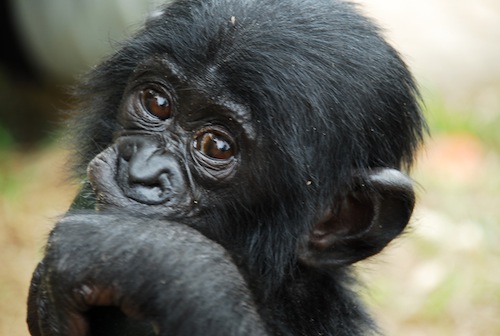 Evolution
Evolution
Open Mouth. Insert Thumb. Suck Vigorously.

This is the recipe for most science journalism about apes and humans and the relationship between the two. It’s a strategy for avoiding thought on hard questions about human evolution and it gets blown away in Doug Axe’s chapter of Science and Human Origins, out this week from Discovery Institute Press.
A recent AP story reflects on the scientific accomplishment involved in mapping the bonobo genome. Bonobos, Pan paniscus, are the politically correct kin of the chimpanzee.
Scientists have found that we are as close genetically to the peace-loving but little-known bonobo as we are to the more violent and better understood chimpanzee. It’s as if they are siblings and we are cousins, related to them both equally, sharing some traits with just bonobos and other characteristics with just chimps.
Bonobos and humans share 98.7 percent of the same genetic blueprint, the same percentage shared with chimps, according to a study released Wednesday by the journal Nature.
If you are reading this, you are not a bonobo.
This business about humans and chimps and bonobos as “cousins” and the figure of 98 percent genetic similarity among all of us is arguably the most exhausted and threadbare image in all of popular science writing. Yet it’s one that science writers keep coming back to again and again, addictively. They have drilled it into the public’s head.
Doug Axe, Caltech-trained director of Biologic Institute, points out that if the transition from ape ancestor to Homo sapiens could be accomplished by the unguided mechanism of natural selection mindlessly sorting random genetic variations, then an infinitely simpler transition should be no less accessible to the same mechanism.
Evolutionists always take for granted that the mechanism works just fine and then proceed directly to the fun part, drawing the Darwinian tree of life. Dr. Axe and his colleague Ann Gauger, a co-author of Science and Human Origins, put the Darwinian assumption to the test by giving it a chance to alter a bacterial gene coding for a particular protein and turn it into a gene coding for a distinct but similar protein. It failed.
The purpose was to observe the development of a new protein function. The evolutionary transition between ape and man, if it happened as Darwinists imagine, must have been accomplished by such minute steps, one after the other. They are all that neo-Darwinian theory has to work with, after all. Unguided evolution, however, was not up to this most basic of imaginable tasks.
Axe writes:
It’s one thing to say that chimps and humans are similar enough that their likeness calls for careful explanation (few would argue with that), but as we’ve now seen it’s quite another to say that they are similar enough for Darwin’s engine to have traversed the gap between them. To insist on that is to ignore the evidence. A comparison of the complete human and chimp genomes has identified twenty distinct gene families, each with multiple genes, that are present in humans but absent from chimps and other mammals. That’s a huge gap when you compare it to the single in-family gene transition that we examined.
If you can’t write a single word, you can’t write a novel. If you can’t take a single step, you can’t run a marathon.
That’s the carefully guarded secret, undeniable science, that somehow never makes it into the popular presentation in the media.
Image: Pan paniscus, Wikicommons.
